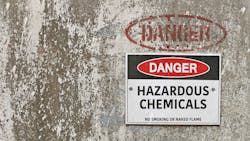Are We Doing Enough to Keep Workers Safe from Harmful Substances?
Haven’t we moved past headlines such as this from The [Everett] Daily Herald: “Boeing workers long exposed to carcinogens far above legal limits”?
At the aerospace giant’s Everett, Wash.-based plant, levels of hexavalent chromium were found that “greatly exceed the legal permissible exposure limit” in the factory’s paint operations. This was a statement from the company’s own compliance manager, Jennifer Allen. She wrote this in an email to colleagues arguing for the elimination of the chemical in the manufacturing process.
Allen went on to warn the Everett plant leadership in 2020 that “literally hundreds of Boeing employees are at risk” of developing lung cancer or other forms of cancer regardless of respiratory protection” from the chemical, which has been a key ingredient in airplane production for decades.
Another apparent case of knowing about the use of hazardous chemicals is Goodyear. The company uses ortho-toluidine in its production process and has been monitoring the air for the chemical since 1976. According to an article on NPR, since 1974 dozens of the plant’s workers have developed bladder cancer. And according to an article from the Center for Public Integrity, DuPont, the manufacturer of this chemical, “knew in 1955 that the chemical caused bladder cancer in laboratory animals and protected its own workers from it but didn’t issue warnings to Goodyear and other customers until 1977.”
And a July 2023 Wall Street Journal investigation revealed that telecom companies have known about the dangers of lead in their underground cables for decades, not only posing a health risk to workers but potentially to those living in nearby communities.
Why are companies exposing workers to chemicals and other materials that are known to be dangerous? Do we rely on the companies to self-regulate? The above examples would show that in many cases, even when companies know of the danger, they don’t always take action.
So that leads to the role of government. Are OSHA standards high enough? An OSHA document called “Permission Exposure Limited- Annotated Tables” says, “OSHA recognizes that many of its permissible exposure limits (PELS) are outdated and inadequate for ensuring protection of worker health. Most of OSHA’s PELs were issued shortly after adoption of the Occupational Safety and Health (OSH) Act in 1970 and have not been updated since that time.”
In an NPR article on the subject of ortho-toluidine, Doug Parker, assistant secretary of labor for occupational safety and health, said, “The requirements of the rulemaking process, including limitations placed by prior judicial decisions, have limited our ability to have more up-to-date standards. Chemical exposure, including ortho-toluidine, is a major health hazard for workers, and we have to do more to protect their health.”
To that end, OSHA has updated its Severe Violator Enforcement Program (SVEP). Changes include expanding program criteria to include all hazards as well as placing employers in the program if they have two willful or repeated violations. Follow-up inspections must be conducted after a year.
“These changes to SVEP will hold a microscope to those employers who continue to expose workers to very serious dangers and help ensure America’s workers come home safe at the end of every shift,” Parker said in a statement. While that might be a first step, I would argue that more pressure must be placed on both OSHA and the companies.
I do find solace in the way that the issue of PFAS, or forever chemicals, is being addressed. With recent reports that these chemicals are now in half of the country’s water supply, a concerted effort on all fronts to do something about this is happening. Industry has responded: 3M, for instance, has said it will stop production of these chemicals by 2025. 3M and DuPont are both facing legal actions due to their prior knowledge of the harmful nature of the PFAS. State governments are also acting by suing manufacturers over these forever companies, saying that harm is coming to residents and natural resources.
And most effective is the fact that everyone now knows about these chemicals, how harmful they are and there is a strong public outcry for something to be done to address this. That same outcry is exactly what needs to happen with the many other dangerous substances workers face every day.
About the Author
Adrienne Selko
Senior Editor
Email [email protected]
Adrienne Selko is also the senior editor at Material Handling and Logistics and is a former editor of IndustryWeek.

